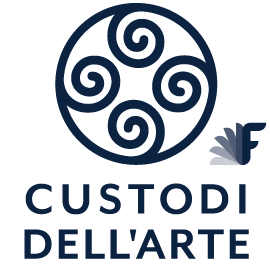

The Murals
The Murals
Riproduci traccia audio
Play audio track
Audio-Track abspielen
The Murals
Trascrizione traccia audio
Even if this stretch of via Baldini does not overlook the Port, the sea seems to flow here through the creativity of Cesenatico’s artists, who, in 1977, painted these 12 murals on the surrounding wall of the Capuchin monastery, creating the illusion of a loggia.
I will tell you about each of them: starting from the left, the wreck of a boat by Gastone Mercuriali, the “improvised” umbrella and the chair on the seashore by Luciano Arfilli, the fishermen with nets by Pino Casali, another wreck by Mercuriali, the fishing huts of Paola Petrini, the rocks created by Mazzanti, the Port Canal by Sergio Trebbi, the ancient rocks and the fishing huts by Franca Pericoli, Mara Caimmi’s two boats, the boat entering the port by Nicola Di Bartolomeo, the two large fisherman’s hands by Peter Knau and finally, the fish by Tonino Cortesi.
It was not the first time that local artists have painted sea scenes on the walls of Cesenatico: the first, as far as I can remember, was Walter Masotti, who in 1975 created the splendid depiction of the Canal and its port in the Piazzetta delle Erbe. In 1976 almost all the beach bars left one facade of their concrete buildings free for murals to be created. It was a wonderful initiative: but sadly, little by little they began to cover them up and whitewash them, until these works completely disappeared. In 1976, Mercuriali painted two large murals in the former Coop, a building that now houses the public Art Gallery; unfortunately, many years later, they too were lost to make room for large windows.
I was born in 1960 and witnessed the artistic passion of that period as a budding painter. The most popular artists, such as Mercuriali, Masotti and Casali, exhibited in their workshops. Those who did not have their own studios formed the Cesenatico Painters’ Association in 1973-1974. In the summer they would exhibit in the evening, in Vicolo della Torre, behind Piazza Ciceruacchio. In those days the artists offered a spontaneous display for everyone, creating a relationship with both citizens and passers-by.
The murals in via Baldini, eroded by the passage of time and the climate of a seaside town, have been restored twice: in 1997, twenty years after their creation, and then again in 2011, when three of the artists who had painted them gave new life not only to their own murals, but also to all the others, thanks to the support of the Beach bar Coop organisation and the Cesenatico town council. The last renovation took place in 2021, when I restored the two works by Mercuriali. While I was at work, I realised just how much the people of Cesenatico are connected to these murals and as they walked by I could hear their encouraging comments “Well done”, “great job”, “it’s about time!”.
My closest bond was that held with Mercuriali with its roots in a time gone by. As a child walking back from the infant School on Via Saffi with my grandfather or my little sister, we would walk along the walls of the Monastery: the best moment for me was when we reached the end of this street, at its intersection with Viale Roma, because there, across the street, at number 20, was Mecuriali’s workshop. In the years that followed I would often go and visit him, from his studio in via Abba, and then when he moved to Piazza Ciceruacchio. I asked him if I could come in to see his paintings, and he always welcomed me kindly, allowing me to watch him whilst he painted behind a booth. On a couple of occasions, we drew pictures of boats whilst sitting side by side, with our feet dangling on the quay of the Canal Port.
Mercuriali’s studio in Viale Roma was on the ground floor and he lived on the upper floor. There is one thing that makes that building unique: in the nineties the artist frescoed the façade, creating a magical combination of characters, animals, still life; Amazons and sea maidens populate fantastic landscapes where, looking carefully, you can see Cesenatico of the past, with the different types of fishing and boats, the still intact fortress, the old Town Hall, the church of San Giacomo seen from the back, like you never see it, and – of course – the Canal and its Port.
If walk on to the end of this road, stop and look up, you too can be enchanted.
Audio Track transcription
Even if this stretch of via Baldini does not overlook the Port, the sea seems to flow here through the creativity of Cesenatico’s artists, who, in 1977, painted these 12 murals on the surrounding wall of the Capuchin monastery, creating the illusion of a loggia.
I will tell you about each of them: starting from the left, the wreck of a boat by Gastone Mercuriali, the “improvised” umbrella and the chair on the seashore by Luciano Arfilli, the fishermen with nets by Pino Casali, another wreck by Mercuriali, the fishing huts of Paola Petrini, the rocks created by Mazzanti, the Port Canal by Sergio Trebbi, the ancient rocks and the fishing huts by Franca Pericoli, Mara Caimmi’s two boats, the boat entering the port by Nicola Di Bartolomeo, the two large fisherman’s hands by Peter Knau and finally, the fish by Tonino Cortesi.
It was not the first time that local artists have painted sea scenes on the walls of Cesenatico: the first, as far as I can remember, was Walter Masotti, who in 1975 created the splendid depiction of the Canal and its port in the Piazzetta delle Erbe. In 1976 almost all the beach bars left one facade of their concrete buildings free for murals to be created. It was a wonderful initiative: but sadly, little by little they began to cover them up and whitewash them, until these works completely disappeared. In 1976, Mercuriali painted two large murals in the former Coop, a building that now houses the public Art Gallery; unfortunately, many years later, they too were lost to make room for large windows.
I was born in 1960 and witnessed the artistic passion of that period as a budding painter. The most popular artists, such as Mercuriali, Masotti and Casali, exhibited in their workshops. Those who did not have their own studios formed the Cesenatico Painters’ Association in 1973-1974. In the summer they would exhibit in the evening, in Vicolo della Torre, behind Piazza Ciceruacchio. In those days the artists offered a spontaneous display for everyone, creating a relationship with both citizens and passers-by.
The murals in via Baldini, eroded by the passage of time and the climate of a seaside town, have been restored twice: in 1997, twenty years after their creation, and then again in 2011, when three of the artists who had painted them gave new life not only to their own murals, but also to all the others, thanks to the support of the Beach bar Coop organisation and the Cesenatico town council. The last renovation took place in 2021, when I restored the two works by Mercuriali. While I was at work, I realised just how much the people of Cesenatico are connected to these murals and as they walked by I could hear their encouraging comments “Well done”, “great job”, “it’s about time!”.
My closest bond was that held with Mercuriali with its roots in a time gone by. As a child walking back from the infant School on Via Saffi with my grandfather or my little sister, we would walk along the walls of the Monastery: the best moment for me was when we reached the end of this street, at its intersection with Viale Roma, because there, across the street, at number 20, was Mecuriali’s workshop. In the years that followed I would often go and visit him, from his studio in via Abba, and then when he moved to Piazza Ciceruacchio. I asked him if I could come in to see his paintings, and he always welcomed me kindly, allowing me to watch him whilst he painted behind a booth. On a couple of occasions, we drew pictures of boats whilst sitting side by side, with our feet dangling on the quay of the Canal Port.
Mercuriali’s studio in Viale Roma was on the ground floor and he lived on the upper floor. There is one thing that makes that building unique: in the nineties the artist frescoed the façade, creating a magical combination of characters, animals, still life; Amazons and sea maidens populate fantastic landscapes where, looking carefully, you can see Cesenatico of the past, with the different types of fishing and boats, the still intact fortress, the old Town Hall, the church of San Giacomo seen from the back, like you never see it, and – of course – the Canal and its Port.
If walk on to the end of this road, stop and look up, you too can be enchanted.
Audiotrack-Text
Even if this stretch of via Baldini does not overlook the Port, the sea seems to flow here through the creativity of Cesenatico’s artists, who, in 1977, painted these 12 murals on the surrounding wall of the Capuchin monastery, creating the illusion of a loggia.
I will tell you about each of them: starting from the left, the wreck of a boat by Gastone Mercuriali, the “improvised” umbrella and the chair on the seashore by Luciano Arfilli, the fishermen with nets by Pino Casali, another wreck by Mercuriali, the fishing huts of Paola Petrini, the rocks created by Mazzanti, the Port Canal by Sergio Trebbi, the ancient rocks and the fishing huts by Franca Pericoli, Mara Caimmi’s two boats, the boat entering the port by Nicola Di Bartolomeo, the two large fisherman’s hands by Peter Knau and finally, the fish by Tonino Cortesi.
It was not the first time that local artists have painted sea scenes on the walls of Cesenatico: the first, as far as I can remember, was Walter Masotti, who in 1975 created the splendid depiction of the Canal and its port in the Piazzetta delle Erbe. In 1976 almost all the beach bars left one facade of their concrete buildings free for murals to be created. It was a wonderful initiative: but sadly, little by little they began to cover them up and whitewash them, until these works completely disappeared. In 1976, Mercuriali painted two large murals in the former Coop, a building that now houses the public Art Gallery; unfortunately, many years later, they too were lost to make room for large windows.
I was born in 1960 and witnessed the artistic passion of that period as a budding painter. The most popular artists, such as Mercuriali, Masotti and Casali, exhibited in their workshops. Those who did not have their own studios formed the Cesenatico Painters’ Association in 1973-1974. In the summer they would exhibit in the evening, in Vicolo della Torre, behind Piazza Ciceruacchio. In those days the artists offered a spontaneous display for everyone, creating a relationship with both citizens and passers-by.
The murals in via Baldini, eroded by the passage of time and the climate of a seaside town, have been restored twice: in 1997, twenty years after their creation, and then again in 2011, when three of the artists who had painted them gave new life not only to their own murals, but also to all the others, thanks to the support of the Beach bar Coop organisation and the Cesenatico town council. The last renovation took place in 2021, when I restored the two works by Mercuriali. While I was at work, I realised just how much the people of Cesenatico are connected to these murals and as they walked by I could hear their encouraging comments “Well done”, “great job”, “it’s about time!”.
My closest bond was that held with Mercuriali with its roots in a time gone by. As a child walking back from the infant School on Via Saffi with my grandfather or my little sister, we would walk along the walls of the Monastery: the best moment for me was when we reached the end of this street, at its intersection with Viale Roma, because there, across the street, at number 20, was Mecuriali’s workshop. In the years that followed I would often go and visit him, from his studio in via Abba, and then when he moved to Piazza Ciceruacchio. I asked him if I could come in to see his paintings, and he always welcomed me kindly, allowing me to watch him whilst he painted behind a booth. On a couple of occasions, we drew pictures of boats whilst sitting side by side, with our feet dangling on the quay of the Canal Port.
Mercuriali’s studio in Viale Roma was on the ground floor and he lived on the upper floor. There is one thing that makes that building unique: in the nineties the artist frescoed the façade, creating a magical combination of characters, animals, still life; Amazons and sea maidens populate fantastic landscapes where, looking carefully, you can see Cesenatico of the past, with the different types of fishing and boats, the still intact fortress, the old Town Hall, the church of San Giacomo seen from the back, like you never see it, and – of course – the Canal and its Port.
If walk on to the end of this road, stop and look up, you too can be enchanted.
Narrato da
Narrated by
Mehr Infos



